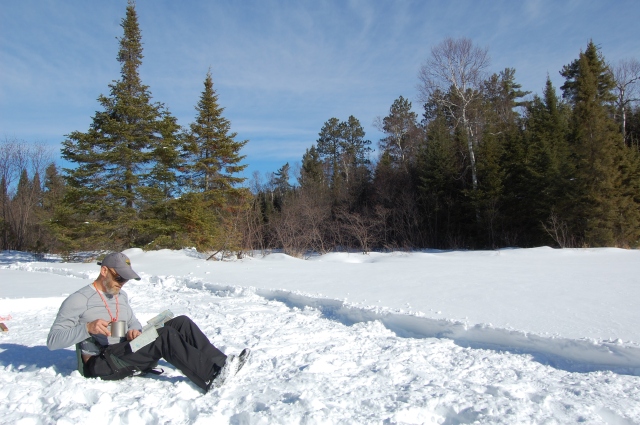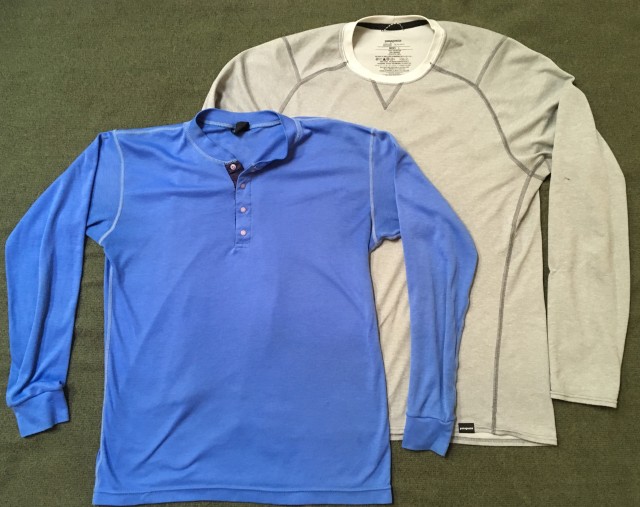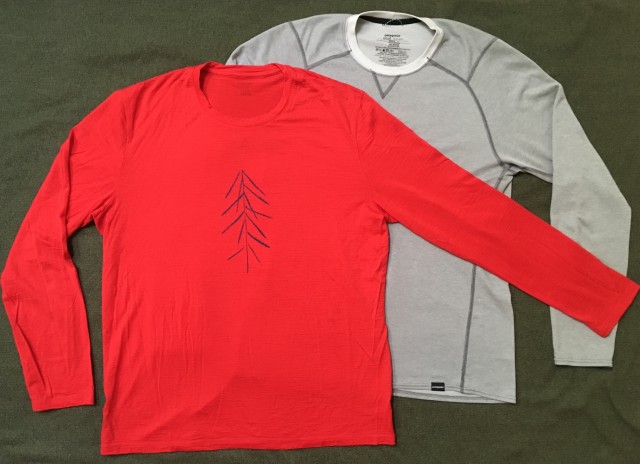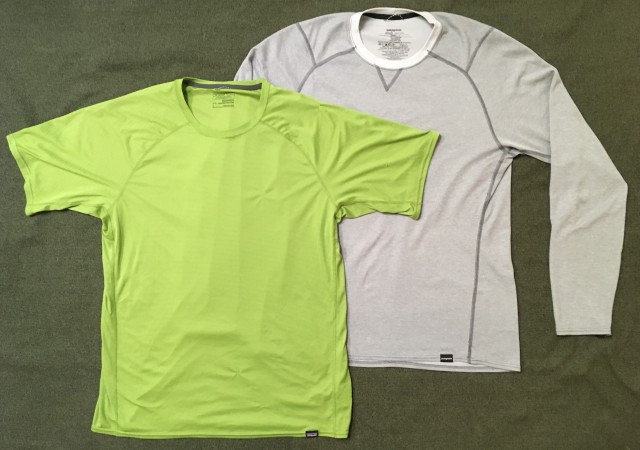
Wicking next-to-skin baselayers are the foundation of any cold weather clothing system. Choices abound. Simplicity beckons.
I Thought You Said Simple
It’s about to get un-simple for a bit. If you want to geek-out on baselayers for a few paragraphs, please read on. If you just want to cut to the chase, scroll on down the page to the Buy This, Not This section.
This is the second part of a series of posts on cold weather clothing. The first post is here.
What do Baselayers Do?
Cold weather baselayers have one real job: to keep your skin as dry as possible. If you are wearing a wet layer next to your skin you are going to feel cold and lose heat to the environment. Good baselayers prevent this from happening in two ways. First, a baselayer wicks perspiration away from your skin and spreads it out across a large area. This helps keep the fabric closest to your skin a dry as possible. Second, baselayer fabrics dry rapidly if they do get soaked during high exertion activities. Quick-drying fabrics get you back to a comfortable baseline rapidly and prevent the kind of chronic cooling that can lead to hypothermia.
Modern synthetic baselayers are usually made of polyester fibers. Polyester is a naturally hydrophobic (water repelling) fabric that dries quickly. Various treatments to polyester fibers can create moisture wicking properties

Patagonia’s original Capeline long underwear was one of the earliest polyester baselayers and it was developed through a combination of serendipity and vision. Yvon Chouinard of Patagonia ran across a polyester fabric created by Milliken that was woven from fibers that had been chemically etched to make water stick to them. This fabric was initially promoted as an easy washing material for sports jerseys, but it turned out to have wicking properties. The etched surface of the fibers would draw water along their length and spread it across the surface of the fabric, but the polyester fibers themselves were hydrophobic, so they would not absorb water. This combination created a fabric that was both wicking and quick to dry. Chouinard believed that this fabric was superior to the polypropylene long underwear that his company has been marketing up until this time, so he discontinued the existing offerings and switch over completely to the new polyester fabric. Patagonia developed a broad range of fabrics that used this technology starting in the 1980s, and ended up dominating the technical baselayer category for decades. Today its safe to say that Capeline is the most recognizable long underwear brand in the in the specialty outdoor category.
A newer technology in polyester baselayers comes from Polartec (formerly Malden Mills), the originator of modern synthetic fleece. Malden’s Powerdry fabric is woven so that the finished material has more surface area on one side than the other. This creates a mechanical wicking action that transports moisture from the inside of the garment to the outside. Power Dry is used by a range of outdoor clothing manufacturers and has been used by Patagonia in some of the newer versions of Capeline.
Silk weight Power Dry is the fabric used in the next-to-skin layer of the US Army ECWCS Gen III cold weather clothing system (for a discussion about the ECWCS Gen III click here). This fabric is branded as Power Dry but it doesn’t have the bi-component knit of the the thicker Power Dry fabrics. I strongly suspect that it is a conventional polyester wicking fabric similar to original Capeline silk weight. In fact, my surplus base layer top actually has a Milliken tag in the hem rather than a Polartec tag. Hmmm…
At any rate, the two wicking technologies described above are different, but both are effective. With Power Dry, moisture is moved from the inside of the fabric to the outside. With the earlier Milliken fabric, the etched fibers caused moisture to spread out from its point of origin to the rest of the garment where body heat could help it to dry. The original Capeline spread moisture out across the fabric evenly both inside and out. Powerdry moves it away from your skin and then spreads it out over the outer layer of the fabric.
Merino wool functions quite a bit like original Milliken Capeline fabric. With Merino, each individual wool fiber is covered with tiny microscopic barbs that act to draw moisture across the fiber through capillary action. This capillary action spreads moisture across the fabric so it can be dried by body heat. Unlike polyester fabrics, wool is somewhat absorbent, which adds to the wicking effect but means that it takes a little longer to dry a wool base layer than a synthetic base layer. Merino wool uses an ultra fine wool fiber, which makes it comfortable to wear next to skin. Most people can comfortably wear merino wool baselayers.

Wool or Synthetic?
Merino wool has made a big splash in the outdoor industry over the past couple decades. Polyester long underwear has been the preferred choice in base layer for twice that time. How do you decide which way to go? It’s all about the stink.
Merino wool does an exceptional job of moderating body odor on extended trips. There are a variety of treatments used to reduce body odor in synthetic baselayers, but none of them is as effective at combating BO as merino wool. I can get a couple good days of continuous wear out of my light weight Capeline top before it starts to get seriously rank. This is despite the Polygiene anti-microbial treatment that Patagonia uses on Capeline. Compare this to the days or weeks of wear I can put on a merino top without smelling much worse than a wet dog. Big difference.
The biggest challenges with merino wool baselayers are their cost and durability. Merino base layers are very expensive–twice as expensive as polyester garments of similar weight. And merino doesn’t hold up as well as polyester. My wife has some 20-year-old Capeline base layers that still look great, while I have several light weight merino tops a few years old that are in various stages of disintegration. Wool fibers aren’t as strong as polyester fibers which means that wool base layers are both more expensive and shorter lived than the synthetic alternatives. This is especially true of the lightest wool baselayers which perform best in this clothing system.
If want superior odor control, wool is the obvious choice. If you’re on a budget or looking for the quickest drying option polyester is the way to go.
Which Weight?
What weight base layer should you buy? If you are looking for the most versatile clothing system possible, you’ll buy the lightest base layer you can find. Lighter fabrics dry more quickly and have a broader comfort range than heavier fabrics. This means if the sun comes out on a winter camping trip and temperatures climb up into the upper 30’s and you start to feel like you’re cooking in your fleece layers you can strip down to your base layer and ski in comfort. Lighter baselayers also double as exercise clothing in milder weather.

If lightweight is the best choice, why are there so many options in long underwear fabrics? If you go to the outdoor store you’ll find silkweight, lightweight, midweight, heavyweight and expedition weight long underwear. What gives?
There are a few reasons for all these choices. First off has to be the tendency toward specialization that we see in high performance products. If you are going for a system that works well in a wide range of conditions, lightweight baselayers are the best choice. But there are conditions where a heavier baselayer might perform better. If you can afford to buy all the different weights you might be able to perfectly tailor your clothing for a given day and given activity for optimum, almost perfect performance. And if you want to do that, all these baselayer options are available to you.
That’s one reason. Another may be that outdoor companies will sell more garments to more people if there are more choices. If you think you NEED a light baselayer for warmer conditions and a midweight base layer for cold but active conditions, you’ll more likely buy two different sets of long underwear. The same thing goes for color. More colors mean more choices and more choices mean more sales. And sales are what keeps the lights on.
Finally, there is probably an element of product positioning at work. When you create different products that sell at different prices (price points in industry jargon) you position some products to seem like a better value than others. All sorts of pricing decisions are worked out this way. Sometimes a product is less profitable to sell, sometimes more, but having a tiered system of products makes it easier to create distinct price points that help to drive sales into specific categories.
So, just buy the lightest stuff you can find and don’t worry too much about it.
[Update: The more I’ve experimented with truly ultralight baselayers the more I believe they work best when paired with wicking fleece insulation like Polartec Power Grid or Polartec Power Dry. Active wicking fleece rapidly draws moisture from baselayers. This means you need less volume of material next to skin to manage moisture. Traditional fleece layers lack this wicking ability and it takes longer for your body heat to drive moisture out of your next-to-skin layer. Another reason to consider performance fleece as part of your outdoor clothing system. See discussion of this topic in my review of Patagonia Capilene Cool Lightweight.]
[Update: As of 2020 Patagonia has discontinued silkweight bottoms from their offerings. They continue to offer Cool Lightweight tops. It appears that they pigeonholed the silkweight stuff so badly that sales fell to the point that the bottoms had to go. This really is a shame because I firmly believe that this weight baselayer offers the greatest versatility across all temperature ranges. Fortunately you can still get surplus and new military silk weight baselayers.]
Color
By all means buy any color that makes you happy. Purple people should buy purple. And if you are into hunting you should buy tan or coyote brown or camo. One thing worth considering is that you should probably buy the lightest shade of your preferred color possible. Light shades will be cooler to wear when the sun is blazing. Black long underwear is hot. Solar powered. A black top on a brilliant sunny winter day will have you sweating your–well–you’ll be hotter than you need to be. So if you are a purple person, go periwinkle. And if you’re hunting, go sand. Lighter shades are a much better choice for all around comfort.
Fit and Features
Lightweight baselayer tops and bottoms should be no-frills garments. There is no need for high collars or zip fronts in tops. These features add unnecessary weight and expense and don’t improve function in lightweight garments. Fit is down to personal preference. Baselayers do not have to fit snugly, so buy something that is comfortable and doesn’t make you feel like a stuffed sausage. Make sure that your top is long enough to stay tucked in.
A Word About Lycra and Nylon
Lycra makes clothes stretch. It makes them fit snugly. Freedom of motion. Good stuff. Problem is that lyrca and similar stretch fabrics are made of nylon, which is a hydrophyllic (water absorbing) material. The more lycra you have in a fabric, the slower it will be to dry. And a baselayer made mostly of nylon is a very poor choice in an outdoor clothing system. Stay away from rash guards, compression clothes and other tight fitting baselayers aimed at football or running. These are great for compression and short term performance, but they will dry slowly and this makes them a poor choice in a backcountry clothing kit.
Buy This, Not This
For a versatile clothing system you should buy a lightweight baselayer made from polyester. Polartec Power Dry silk weight or similar is an excellent choice. If you’re going on extended trips you may want to try the lightest weight merino wool you can find as a baselayer for your upper body. The merino won’t dry as quickly as polyester baselayers but it will definitely be more pleasant to smell. Polyester bottoms may suffice and will cost half as much as wool bottoms. Light colors are best, particularly in tops.
For the most versatile system, don’t buy midweight base layers. Don’t buy heavyweight or thermal weight or expedition weight base layers either. Stick to lightweight fabrics that can be layered under insulation or worn alone in warmer conditions.
If you don’t mind the color tan, check out the silkweight options available as surplus from the US military. They typically cost half or less the comparable offerings from commercial sources.
Sources:
The PCU Protective Clothing Uniform: A Buyer’s Guide and Clothing System History
If you enjoyed this post, please consider subscribing to Kitchi-Gami.com by using one of the links in the menu on the right side of the screen. On your mobile device you’ll find the links if you scroll to the bottom of the page. Thanks!

Hey Brian,
Thank you for this fantastic series! It’s really changed how I’m approaching my winter gear.
Quick question: Do you know anything about the Polartec Powerdry FR (Flame resistant) ? Is it chemical based?
https://www.polartec.com/fabrics/military/power-dry-flame-resistant
I ask because the USMC issued FROG Grid Fleece pullovers seem a lot more available than the USGI Army Grid Fleece now days.
The FR and kangaroo pocket seem to be the only differences.
I really don’t want a chemical FR coating though.
Thanks!
Thanks! Glad you’re enjoying the series.
Looks like Powerdry FR is a blend of Lyocell, Modacrylic and Aramid. Power grid FR adds a little Lycra.
Lyocell is a cellulose based fiber that’s hydrophilic. Both modacrylic and aramid are hydrophobic like polyester.
Looks like they’re blended together into bi component wicking fabrics (just like standard Powerdry and Powergrid). Likely with the Lyocell on the face fabric and the other fibers next to skin.
No chemical FR treatments. All inherently fire resistant fibers.
Performance wise should be similar to Powerdry/Powergrid with somewhat slower dry times due to the Lyocell.
I had a Drifire top that was a modacrylic blend. It was hotter and slower to dry than the Miliken silk weight fabric that’s used in the ECWCS L1 top and bottom. So far I’ve skipped the FROGskin pieces because of this.
Bottom line, looks like a little longer dry time in exchange for the FR properties, which would be very desirable in combat operations.
Thanks for asking that question. I hadn’t researched these products and they’re definitely popping up surplus right now. Great to learn a little more about them.
Awesome, thanks for the reply and the great info!
I guess I will keep trolling ebay for the Army version, the FR doesn’t sound like a great tradeoff for my purposes.
For the waffle Powergrid pieces, mostly only XS, XXL, or really beat used ones available right now 😦
But I am glad it’s not chemical – That is very cool.
I’d b tempted by the grid. Not sure about the next to skin layer. Thanks again!
An important take on base layers. Long ago I made the mistake of using heavier base layer pieces, especially for cold weather. These never move moisture and dry as well as lighter base layers. They ought to be considered light insulation layers, and my beloved R1 gear is about the thickness of Expedition Weight Capilene…
I’ve been a huge fan of the Silkweight Capilene items; I probably still have shirts from all the versions up to the “cool” gear. One reason I like Silkweight is that it offers some sun protection, and so could be worn alone as a summer shirt. Capilene Lightweight (or sometimes Cap 1), by contrast, was airy and designed for maximum moisture movement. Silkweight never seemed to dry as quickly as the “1” shirts, but did offer some wind resistance and sun protection that the other version did not.
I have one Silkweight shirt from at least a decade ago that has significant amount of Lycra in the weave. In a base layer. Not sure where they were going with that, but it sure is slow to dry…
Hi Dennis, 100 percent agree. The old expedition weight stuff was about 100g/m. It’s definitely lightweight insulation and never did work well next to skin. By comparison, R1 actually does wick a little bit as a baselayer, but I almost always layer it over silkweight. Discussion of lightweight fleece layers here:
I like the silkweight enough that I did a standalone review. I think it’s the only baselayer a person needs.
Of course, in keeping with longstanding tradition of dumping anything that’s too good, Patagonia has dumped silkweight bottoms after pigeonholing silkweight as a hot weather layer only. SMH.
I’ve got a set of the “1” layer. They’re nice under a dry suit because they’re a little thicker. I do think the bi-component knit of Power Dry dries a little quicker, but I prefer the versatility of silkweight for 4 season use.
And why anyone would put a load of nylon lycra in a wicking baselayer is beyond me. This is my big gripe with the Under Armor stuff.
Thanks again for the thoughtful comments